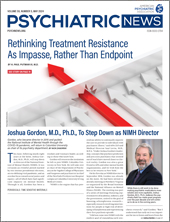Smoking has overtaken injection as the most commonly documented route of substance use that leads to an overdose death in the U.S., a
study in
Morbidity and Mortality Weekly Report has found.
“These results are important because the routes through which people use drugs have implications for overdose risk, infectious disease transmission, other comorbidities (such as abscesses), and harm reduction services,” lead author Lauren J. Tanz, Sc.D., told Psychiatric News. She is a senior scientist in the Division of Overdose Prevention at the Centers for Disease Control and Prevention (CDC) National Center for Injury Prevention and Control.
Tanz and colleagues examined data from the CDC’s State Unintentional Drug Overdose Reporting system to track trends in routes of substance use in overdose deaths in 27 states and the District of Columbia. Their research included data amassed from January 2020 to December 2022. They identified routes of substance use from witness reports, autopsy data, or investigations of the overdose scene, and they separated routes of substance use into four main categories: ingestion, injection, smoking, and snorting. (A small percentage of overdose deaths involved other routes such as suppositories, but these were not included.) A total of 139,740 overdose deaths occurred in these 28 jurisdictions over the three years, and 51.2% had at least one of these four documented routes of drug use.
During the first six months of the study (January–June 2020), the leading route of use in overdose deaths was injection at 22.7%, followed by ingestion at 15.2%, snorting at 13.6%, and smoking at 13.3%.
However, compared with January–June 2020, the number of overdose deaths with evidence of smoking increased 109.1% during the last six-month period (July–December 2022). Between these same timeframes, the number of overdose deaths with evidence of injection decreased 14.6%. Overall, total overdose deaths increased by 20.2% between January–June 2020 and July–December 2022.
As a result, from July–December 2022, the leading route of use in overdose deaths was smoking at 23.1%, followed by snorting at 16.2%, injection at 16.1%, and ingestion at 14.5%.
Tanz said that there are several possible reasons for the shift from injection to smoking in overdose deaths.
“[This shift] might be partially driven by transitions from injecting heroin to smoking illegally made fentanyl and fentanyl analogs; increases in deaths that co-involve illegally made fentanyl and fentanyl analogs and stimulants, which are often smoked; and increases in the use of counterfeit pills, which are commonly smoked,” she said.
Tanz said the rise in smoking-related overdose deaths may also be an indicator that more people are choosing to smoke versus inject drugs in general. Factors that may drive individuals to smoke include the following:
•
A perception that smoking is safer since the risk of adverse effects such as abscesses and bloodborne infections is mitigated.
•
The reduced cost and stigma of smoking compared with injection.
•
A sense of control over drug quantity consumed, such as being able to smoke a small amount of a substance over time versus taking a single large injection.
•
The perception that smoking has a lower risk of overdose than injection.
Tanz noted that the analysis only included fatal drug overdoses, so it is possible that trends in routes of substance use are different for people who use substances in general and for people who have nonfatal overdoses.
She stressed the need for expanded messaging that emphasizes overdose risk associated with smoking and other noninjection routes of substance use.
“People who use drugs by any route, whether injection, smoking, snorting, etc., need to know the potential risk for overdose, and linking them to harm reduction and treatment services could be lifesaving,” she said. “It is also important to ensure access to naloxone and provide education around recognizing signs and symptoms of overdose for people who use drugs and their friends and family.”
Tanz added that harm reduction services should be comprehensive and available for all individuals who use substances, regardless of their method of use.
“People who use drugs by smoking or other noninjection routes but do not inject drugs might not use traditional syringe service programs where harm reduction messaging and supplies are often provided,” Tanz explained. “We’ve seen that some jurisdictions have adapted their harm reduction services to provide safer smoking supplies and expand outreach to people using drugs by noninjection routes. These approaches might improve access to lifesaving supplies such as naloxone and fentanyl test strips, [as well as] services for people who use drugs by any route.”
The researchers reported no outside funding for this study. ■


